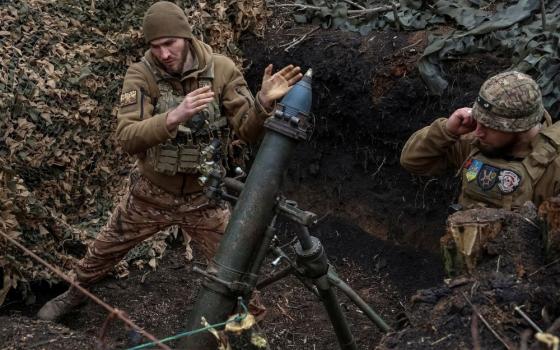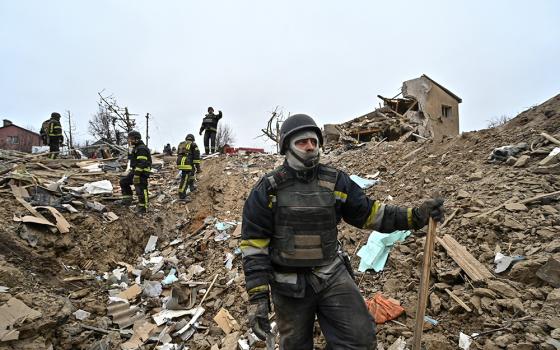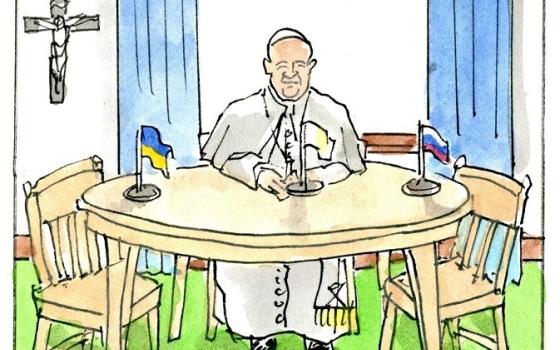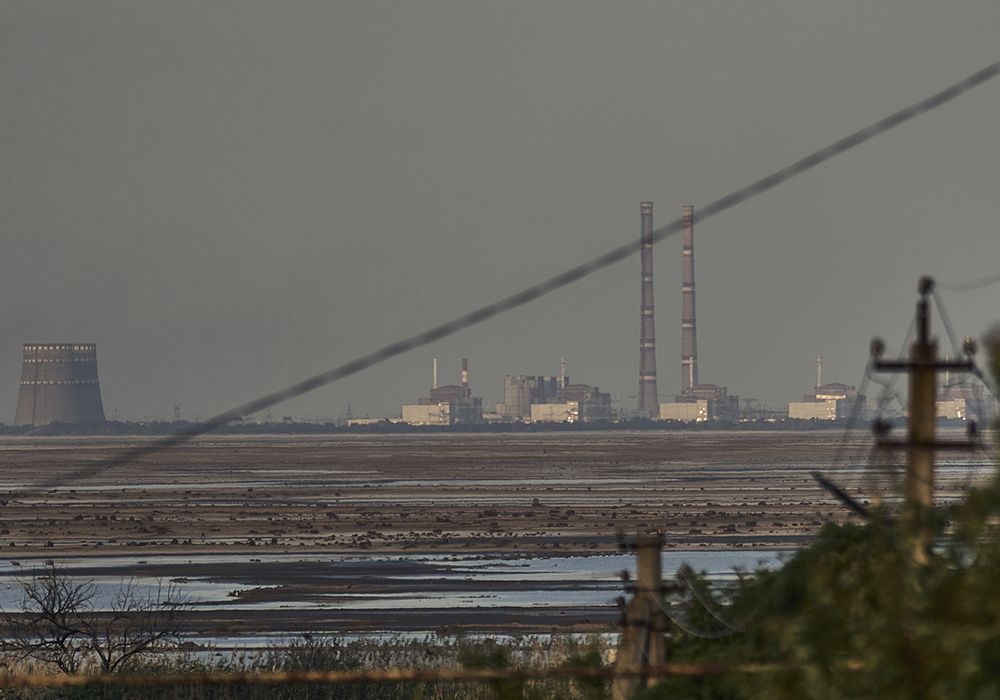
The Zaporizhzhia Nuclear Power Plant, Europe's largest, is seen in the background of the shallow Kakhovka Reservoir after the dam collapse, in Energodar, Russian-occupied Ukraine, June 27. Ukraine and Russia accused each other Wednesday, July 5, of planning to attack the power plant, which is occupied by Russian troops, but neither side provided evidence to support their claims. (AP photo/Libkos, File)
Editor's note: Claire Schaeffer-Duffy traveled to Ukraine in April with the Zaporizhzhia Protection Project's exploratory team.
Few people have done more to prevent a nuclear catastrophe in Ukraine than a Catholic father of eight, Rafael Mariano Grossi. For more than a year, the energetic director general of the International Atomic Energy Agency, or IAEA, has worked tirelessly to protect Ukraine's Zaporizhzhia Nuclear Power Plant, the largest nuclear power plant in Europe. Pre-war, it provided one-fifth of Ukraine's energy needs and was a source of local pride.
But the asset became a hazardous liability after Russia seized the power plant in March of 2022. In recent days, Ukrainian President Volodymyr Zelenskyy said Russian troops have placed "objects resembling explosives" on roofs at the plant, raising concerns about an attack.
Located on the southern bank of the Dnipro River in the Zaporizhzhia oblast, the plant today sits on the war's front lines. It has six nuclear reactors and 37 years of nuclear waste stored in unprotected cooling pools. A military strike at the facility could render a large swath of Ukraine uninhabitable for decades and disperse radioactive material into Russia as well as into western Europe.
After a spate of shelling at the Zaporizhzhia Nuclear Power Plant last August — each side blaming the other — Grossi tried valiantly to establish a safety zone around the plant, meeting with Zelenskyy, then with Russian President Vladimir Putin.
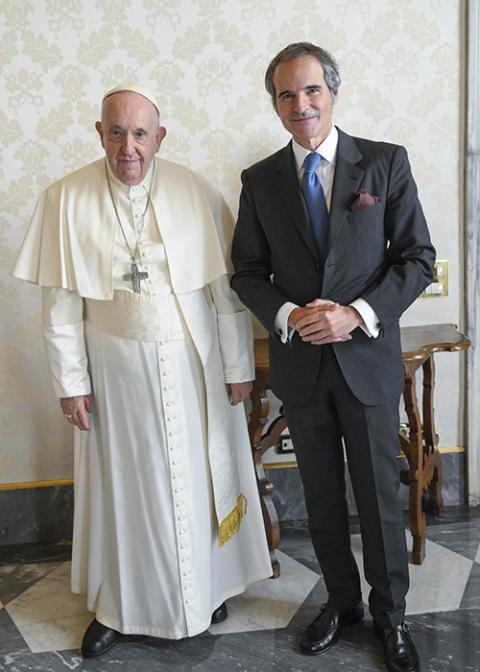
Pope Francis and Rafael Mariano Grossi, director general of the International Atomic Energy Agency, pose for photos Jan. 12 in the library of the Apostolic Palace. Grossi said they discussed the threat of a disaster from bombings of a nuclear power plant in Ukraine. (CNS photo/Vatican Media)
"Obviously it is not an easy negotiation," because the area is a zone of intense military activity, Grossi said during a January visit with Pope Francis. "My challenge is to get to a point where there is a 'sanctuary-ization' … of the plant that is seen, not as a problem, but as a solution to any more serious consequences."
Since last September, Grossi has deployed rotating teams of International Atomic Energy Agency inspectors to monitor the plant. Their weekly public reports have kept international focus on a place of generational and borderless hazards. On May 30, he appeared before the U.N. Security Council to report on the plant, the fourth such meeting since Russia's invasion last year.
Unable to achieve his desired safety zone, Grossi came with a list of more modest yet concrete asks, his five principles:
- No attacks of any kind targeting the plant, its reactors, spent fuel storage, other critical infrastructure or personnel.
- No using the plant as a storage site for heavy weapons or base for military personnel who could attack from the plant.
- No putting the plant's offsite power sources at risk.
- Protect all structures, systems and components essential to the safe and secure operation of the plant from attacks or acts of sabotage.
- Take no action that undermines the preceding principles.
In mid-June, Grossi visited the plant for the third time. The disastrous destruction of the Kakhovka Dam, located downstream, had just happened, jeopardizing the water supply for the plant's cooling system. Recent military action in the area damaged the road leading to the Zaporizhzhia compound so Grossi and his team walked the final stretch.
Videos on his Twitter feed show him standing at the war's front line and striding up an embankment to report on the water level of the plant's cooling pond. After the inspection, shelling in the area briefly halted IAEA vehicles returning to Ukrainian-controlled territory. That did not deter Grossi who went to Kaliningrad, Russia, the following week to review his five principles with authorities there.
Grossi's courageous persistence and that of the IAEA inspectors captured the imagination of Dr. John Reuwer, a retired emergency room physician and board member of the international organization World Beyond War. An experienced veteran of international and domestic peace teams, Reuwer was particularly impressed with the inspectors' non-partisan mission.
Here were unarmed monitors entering an occupied war zone to protect a nuclear power plant for the sake of the common good. And they were doing so without any formal training in unarmed civilian protection. Could teams of internationals skilled in this nonviolent strategy amplify the International Atomic Energy Agency's efforts?
Advertisement
For months, Reuwer and others affiliated with a small international movement known as the Zaporizhzhia Protection Project have been training people for this purpose. The project envisions at least a symbolic presence of a few dozen unarmed civilian protectors at the plant to accompany the IAEA monitors, or better yet, hundreds to patrol the facility to help enforce Grossi's five principles. After all, why should preventing nuclear catastrophe fall on the director general's shoulders alone?
As its name implies, unarmed civilian protection entails deploying unarmed people to protect civilians caught in violent conflict. The nonviolent strategy has been in use for decades. During the wars in Central America, unarmed internationals, providing round-the-clock accompaniment, successfully protected human rights defenders targeted for assassination. More recently, it has been effectively applied in diverse places such as inner-city Chicago, South Sudan and Iraq to mitigate the spread of gang violence, or protect displaced peoples living in camps or returning to contested areas.
The Zaporizhzhia Protection Project represents a far more ambitious application for the geopolitical fight fueling the Russia-Ukraine war is much bigger, and more lethal, than Chicago gang duels or intercommunal conflicts in Iraq or Sudan.
In April, the project sent an exploratory team to Ukraine to probe the waters. The Ukrainians interviewed invariably expressed skepticism when asked about non-military means for protecting the power plant. The Russians were liars and could never be trusted, they said.
But as conversations focused on the hazards of the military option, some, like the young deputy mayor of a town located near the plant, became curious. "Do you have some kind of step-by-step plan," he asked. "What exactly do you propose?" (The mayor's name has been withheld for security reasons.)
"Approximately 50 tons of plutonium have been accumulated at the Zaporizhzhia Nuclear Power Plant," said Russian engineer-physicist and environmentalist Oleg Bodrov during a December presentation for Massachusetts Peace Action. By comparison, the atomic bomb dropped over Nagasaki contained 14 pounds). What this means is that the possible consequences of bombing the plant are too enormous to predict. Everyone knows this.
Some threats are so vast they impose agreement even among the fiercest of enemies. For all the denunciations and finger-wagging at the May 30 session of the Security Council, the members agreed on one point: The power plant must be protected. Right now, Grossi and his small agency bear the burden of implementing that impossibly difficult task. The Zaporizhzhia Protection Project wants to help.





